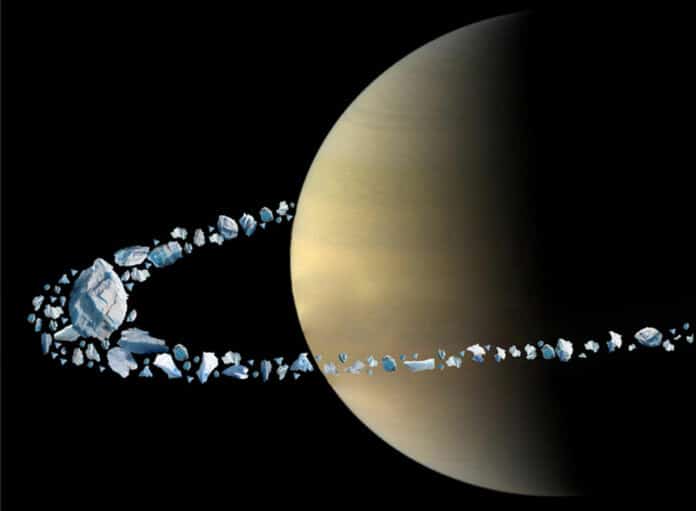Saturn’s rings are about 100 million years old, but it is unclear how they could have formed so recently. The belted giant rotates at a 26.7-degree angle relative to the plane in which it orbits the sun.
Since Saturn’s tilt precesses, like a spinning top, at almost the same rate as Neptune’s orbit, astronomers have long hypothesized that this tilt results from gravitational interactions with its neighbor Neptune.
While the two planets may have once been in sync, astronomers at MIT and other universities have discovered that Saturn has since eluded Neptune’s pull.
What caused this realignment of the planets?
The team comes up with a new hypothesis. They proposed that the Saturn system previously contained an additional moon named Chrysalis. Along with other moons, Chrysalis orbited Saturn for several billion years, pulling and tugging on the planet in a way that kept its tilt, or “obliquity,” in resonance with Neptune.
Chrysalis, however, is thought to have become unstable some 160 million years ago and came too close to its planet in a grazing encounter, which tore the satellite apart. The loss of the moon was sufficient to free Saturn from Neptune’s pull and give it the present-day tilt. Furthermore, a fraction of the Chrysalis’ fragments could have remained suspended in orbit, eventually breaking into small icy chunks to form the planet’s signature rings.
Astronomers suggest that this missing moon could explain two longstanding mysteries: Saturn’s present-day tilt and the age of its rings, which were estimated to be about 100 million years old — much younger than the planet itself.
Jack Wisdom, professor of planetary sciences at MIT and lead author of the new study, said, “Just like a butterfly’s chrysalis, this satellite was long dormant and suddenly became active, and the rings emerged.”
During the early 2000s, scientists hypothesized that Saturn had a tilted axis because of its gravitational resonance or connection with Neptune. However, Cassini, a NASA spacecraft that orbited Saturn from 2004 to 2017, made discoveries that gave the problem a fresh angle. Titan, Saturn’s largest satellite, was discovered to be migrating from Saturn at a rate of roughly 11 centimeters per year, which was faster than anticipated. This fast migration and its gravitational pull enabled scientists to conclude that the moon was likely responsible for tilting and keeping Saturn in resonance with Neptune.
Jack Wisdom, professor of planetary sciences at MIT and lead author of the new study, said, “To make progress on the problem, we had to determine the moment of inertia of Saturn.”
In this new study, scientists looked to pin down Saturn’s moment of inertia using some of the last observations taken by Cassini in its “Grand Finale,” a phase of the mission during which the spacecraft made an extremely close approach to precisely map the gravitational field around the entire planet. The gravitational field can be used to determine the distribution of mass on the planet.
They modeled Saturn’s interior and identified a mass distribution that matched the gravitational field that Cassini observed. Surprisingly, this newly identified moment of inertia placed Saturn close to but just outside the resonance with Neptune. The planets may have once been in sync but are no longer.
They started by performing simulations to evolve the orbital dynamics of Saturn and its moons backward in time. They wanted to determine whether any natural instabilities among the existing satellites could have influenced the planet’s tilt. This search came up empty.
To better understand how a planet’s axis of rotation shifts over time, known as precession, the scientists reexamined the mathematical equations that describe it. One term in this equation has contributions from all the satellites. The team reasoned that if one satellite were removed from this sum, it could affect the planet’s precession.
By running simulations, scientists determined the properties of Chrysalis, including its mass and orbital radius, and the orbital dynamics that would be required to knock Saturn out of the resonance. They conclude that the resonance between Saturn and Neptune caused the planet’s current tilt, and the loss of the satellite Chrysalis, roughly the size of Saturn’s third-largest moon Iapetus, allowed Saturn to avoid the resonance.
Scientists noted, “Sometime between 200 and 100 million years ago, Chrysalis entered a chaotic orbital zone, experienced several close encounters with Iapetus and Titan, and eventually came too close to Saturn, in a grazing encounter that ripped the satellite to bits, leaving a small fraction to circle the planet as a debris-strewn ring.”
“The loss of Chrysalis explains Saturn’s precession, and its present-day tilt, as well as the late formation of its rings.”
Wisdom said, “It’s a pretty good story, but like any other result, it will have to be examined by others. But it seems that this lost satellite was just a chrysalis, waiting to have its instability.”
Journal Reference:
- Jack Wisdom et al. Loss of a satellite could explain Saturn’s obliquity and young rings. SCIENCE. DOI: 10.1126/science.abn1234
